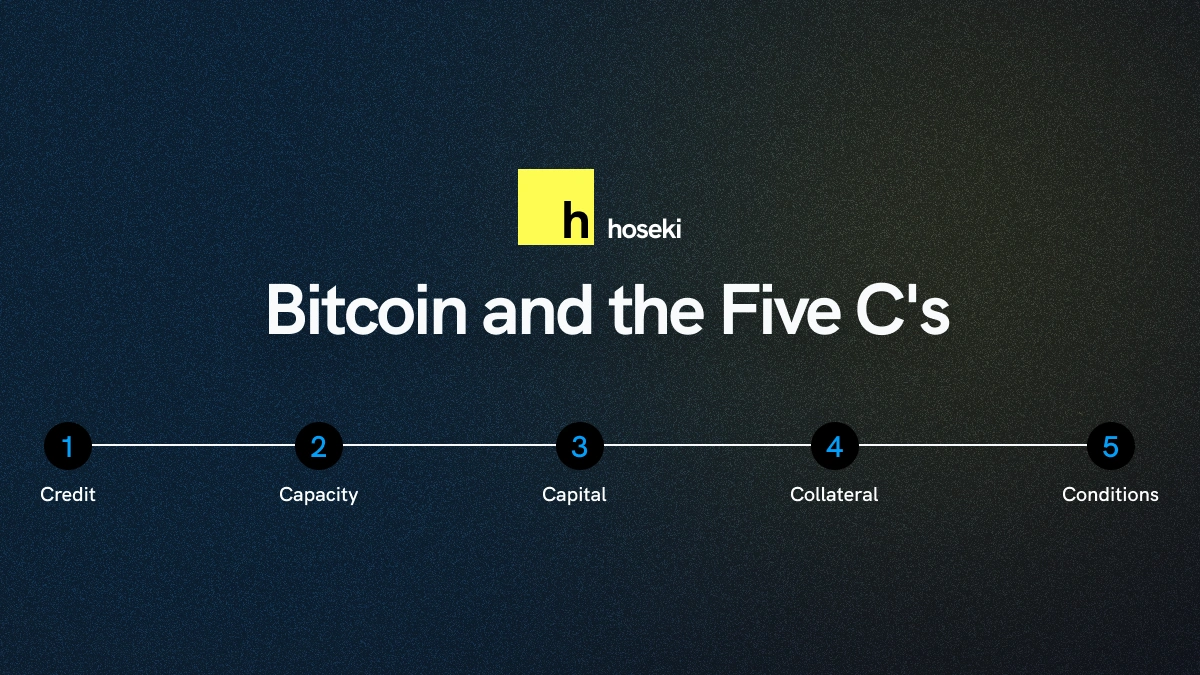
Bitcoin and the 5 C's: An Introduction
The emergence of Bitcoin is still a brand new phenomenon. The implications of Bitcoin simply existing has not yet been fully realized by most and certainly not yet fully appreciated by traditional finance. As adoption spreads worldwide by individuals, institutions and nation states, everyone is beginning to comprehend the ways in which Bitcoin enables the world to reimagine its relationship to money entirely.
Perhaps one of the most under-appreciated aspects of Bitcoin is how it fundamentally transforms a lender’s ability to properly evaluate risk. In order to explore this claim further, it’s necessary to first examine some of the most common ways traditional lenders currently evaluate risk. A popular lens for understanding how lenders assess the risk profile of a potential borrower is known as The Five C’s: Credit, Capacity, Capital, Collateral and Conditions.
This is the first article in a series about each of these C’s.
To start, this article briefly defines each C and then unpacks each one later in this series.
CREDIT
The average American learns fairly early on the importance of maintaining a solid credit history and subsequently earning a respectable credit score. Sometimes this “C” is even referred to as “Character” which shows how critical it is to a lender’s decision making process prior to approving a loan. Within the realm of Credit, there are several sub-factors that go into generating a credit score. This includes: length of time credit has been established, on-time payment history, amount of available credit utilized, amount of revolving credit (i.e. credit cards) compared to installment loans (i.e. mortgage or car loan).
CAPACITY
A borrower must demonstrate a clear ability to repay or service the new loan payment they are applying for by documenting their debt-to-income ratio. A borrower with too many existing obligations without an acceptable level of relative income, is considered higher risk to a lender.
CAPITAL
Ensuring a potential borrower is well capitalized is certainly in every lender’s best interest. By requiring a loan applicant to provide proof of their cash on hand, retirement funds and other assets, the lender is provided some comfort that the new debt obligation could still be serviced, even if the capacity of a borrower is diminished.
COLLATERAL
One of the most tangible and actionable elements of lending is the collateral a borrower pledges as security for the loan. A home purchase utilizing a mortgage or a car purchase utilizing an auto loan are considered “secured” loans which are ultimately backed by the pledged collateral. This means that in the event of a default (aka non-payment), the lender can seize the collateral as recourse. Unsecured credit such as Credit Cards or Student Loans, are more risky for lenders because they lack collateral.
CONDITIONS
The most subjective of the five 5 C’s is concerned with the broader purpose of the loan and underlying conditions in which the borrower is requesting financing. What is the loan amount? What will the funds be used for? How will the other C’s be impacted by this new loan? Are there compensating factors (i.e. positive aspects of a borrower’s financial profile which may compensate or make up for other aspects where the borrower is not as strong) that should be taken into consideration? Evaluating the conditions can also play a role in determining the rate and fee structure of the loan with higher risk loans generally being more expensive and loans that are considered to be safer receiving more favorable terms.
The logic behind why lenders would utilize the 5 C’s framework is relatively self-evident on the surface. If you consider our current financial and societal realities, these are perhaps the best methods available for a lender to adequately assess risk. These have been the tried and true methods for determining which types of borrowers are most likely to pay back their loans on time and in full.
However, what happens to the 5 C’s when the financial and societal paradigms begin to shift into a bitcoin standard? Do bitcoin’s unique properties enhance underwriting strategies and offer potential lenders better tools to evaluate creditworthiness? While several bitcoin lending companies have already emerged in pursuit of securing these nascent advantages, we are still in the very early stages of realizing the true potential of how Bitcoin significantly upgrades risk-assessment.
It’s difficult to imagine a world where FICO scores are not the bedrock of how lenders make decisions. But just like fiat money itself, FICO is a relatively new phenomenon (created in 1956) and just like fiat money itself, its days are likely numbered. So how did everything become so reliant and entrenched in this FICO Score world? And how will this institution be impacted in a post-hyperbitcoinization world? Keep reading to dive in deeper and unpack those questions in part two of this series.